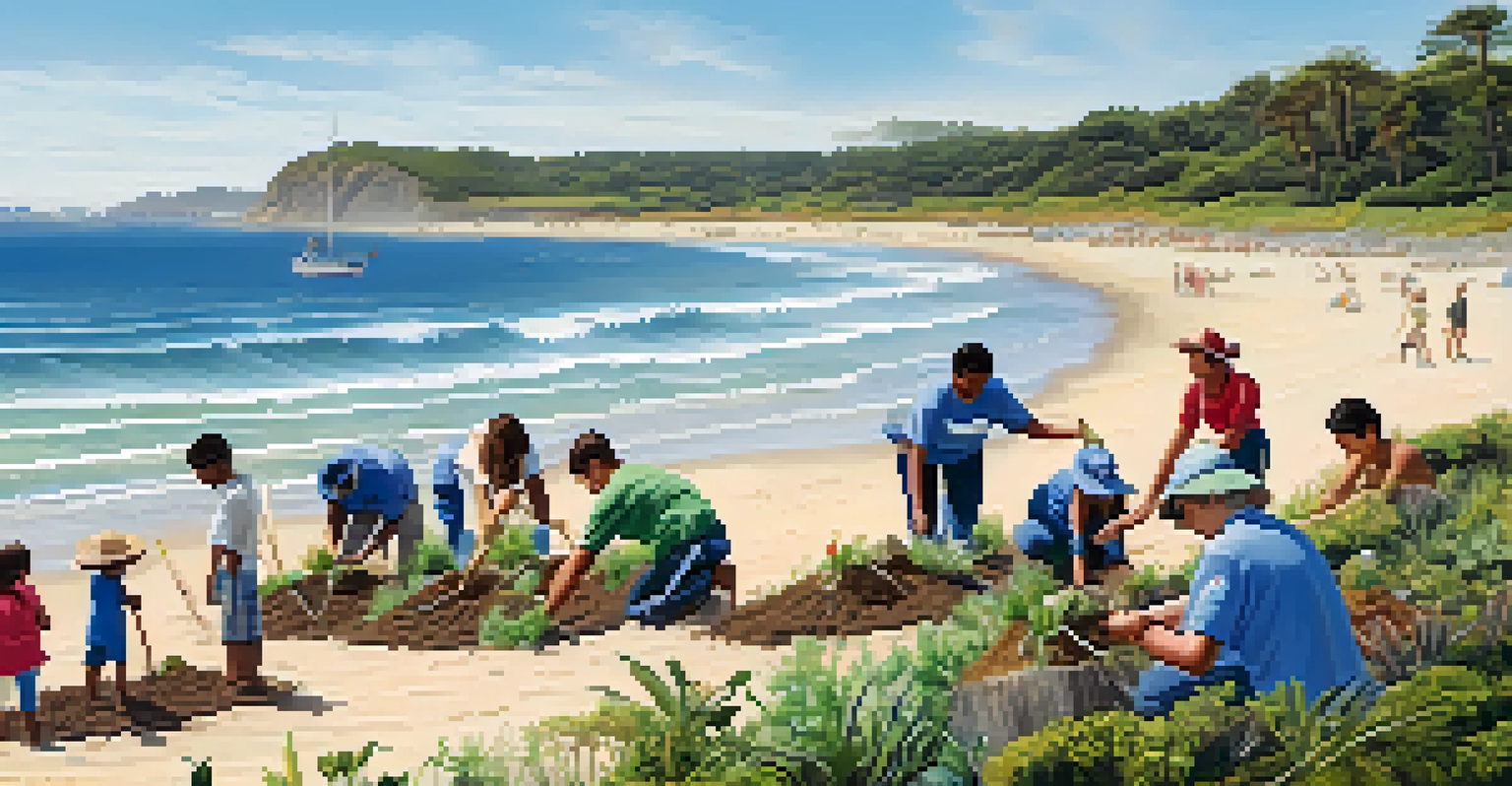Texas Coastal Habitats: Wildlife and Conservation Challenges

Understanding Texas Coastal Habitats and Their Importance
Texas coastal habitats encompass a diverse range of ecosystems, including marshes, estuaries, and barrier islands. These areas serve as crucial nurseries for fish and invertebrates, underpinning the richness of both wildlife and local fishing industries. By providing shelter and breeding grounds, they play a pivotal role in supporting both aquatic and terrestrial life.
The environment is where we all meet; where we all have a mutual interest; it is the one thing all of us share.
The unique geography of the Texas coast, with its mix of freshwater and saltwater, creates a dynamic environment that fosters biodiversity. For instance, the estuaries are not just transitional zones but vibrant ecosystems that filter pollutants and provide vital habitats for migratory birds. Understanding this complexity helps us appreciate the ecosystems' fragility and importance.
Moreover, these habitats contribute significantly to the state’s economy through tourism, recreation, and commercial fishing. As we delve deeper into the wildlife that inhabits these areas, it becomes clear that protecting these ecosystems is essential for both environmental health and economic sustainability.
Key Wildlife Species of Texas Coastal Habitats
The Texas coast is home to an array of wildlife, from migratory birds like the endangered whooping crane to various species of fish. These creatures rely on the coastal environment for survival, making it vital to understand their roles within the ecosystem. For example, the presence of healthy seagrass beds supports many marine species and helps maintain water quality.

In addition to birds and fish, the coastal habitats support a variety of mammals, reptiles, and amphibians, each contributing to the intricate web of life. The Kemp's ridley sea turtle, one of the most endangered sea turtles, is often seen nesting along Texas beaches. Protecting these species is crucial, not just for their survival but for the overall health of the coastal ecosystem.
Importance of Coastal Ecosystems
Texas coastal habitats are vital for biodiversity, supporting marine life and the local economy through fisheries and tourism.
The interaction between these species highlights the delicate balance that exists in these habitats. Disruptions, whether from human activity or natural disasters, can have cascading effects on the entire ecosystem, emphasizing the need for comprehensive conservation strategies.
Major Conservation Challenges Facing Coastal Habitats
Despite their importance, Texas coastal habitats face significant conservation challenges. Urban development, pollution, and climate change are leading threats to these delicate ecosystems. As cities expand and industries grow, natural habitats are being lost or degraded, which can disrupt local wildlife populations.
In every walk with nature, one receives far more than he seeks.
Pollution, particularly from agricultural runoff, poses another serious risk. Chemicals and nutrients can lead to harmful algal blooms that deplete oxygen in the water, creating dead zones where marine life cannot survive. Addressing these issues requires cooperative efforts from local communities, government agencies, and conservation organizations.
Climate change adds another layer of complexity, with rising sea levels and increasing storm intensity threatening coastal areas. It's crucial to implement effective conservation strategies that not only protect existing habitats but also enhance their resilience to these changing conditions.
The Role of Nonprofit Organizations in Conservation
Nonprofit organizations are at the forefront of conservation efforts along the Texas coast. These groups work tirelessly to protect habitats, advocate for policies, and educate the public about local wildlife. Their initiatives often include habitat restoration projects, which can help revive degraded areas and support biodiversity.
Collaborations between nonprofits, governmental agencies, and local communities are essential for successful conservation efforts. By pooling resources and expertise, these partnerships can tackle larger projects that benefit both wildlife and people. For instance, initiatives to restore marshlands often involve local volunteers who gain a deeper understanding of their environment.
Conservation Challenges Ahead
Urban development, pollution, and climate change threaten the health of Texas coastal ecosystems, necessitating urgent conservation efforts.
Public awareness campaigns led by these organizations also play a significant role in fostering a conservation mindset. By engaging the community and highlighting the importance of coastal habitats, nonprofits inspire individuals to take part in preservation efforts, whether through volunteering or advocating for policy changes.
Local Communities and Their Impact on Coastal Conservation
Local communities are vital stakeholders in the conservation of Texas coastal habitats. Their daily activities and traditions, such as fishing and recreational boating, directly influence the health of these ecosystems. When communities understand the impact of their actions, they can become powerful advocates for conservation.
Community-led initiatives often focus on sustainable practices that protect wildlife while supporting local economies. For example, promoting eco-tourism can offer economic benefits while fostering a deeper appreciation for the natural environment. This approach not only enhances local livelihoods but also encourages responsible interaction with nature.
Moreover, local knowledge and traditions can provide valuable insights into the ecosystem that may not be captured by scientific studies alone. Engaging communities in conservation efforts ensures that their voices are heard, creating a more sustainable approach that respects both the environment and the people who depend on it.
Government Policies Affecting Coastal Habitat Protection
Government policies play a crucial role in shaping the conservation landscape for Texas coastal habitats. Regulations regarding land use, pollution control, and wildlife protection are essential for maintaining these ecosystems. However, the effectiveness of these policies often hinges on enforcement and public support.
Recent initiatives aimed at improving habitat protection have seen mixed results. While some policies have successfully reduced pollution levels and promoted habitat restoration, others have faced challenges due to funding limitations or political opposition. Advocacy for stronger protections is needed to ensure that the unique ecosystems of the Texas coast are preserved for future generations.
Role of Communities in Conservation
Local communities are crucial in protecting coastal habitats by promoting sustainable practices and engaging in conservation initiatives.
Additionally, collaboration between state and federal agencies can enhance conservation efforts. By aligning goals and resources, these partnerships can create comprehensive strategies that address both environmental and economic concerns, ensuring a balanced approach to coastal management.
The Future of Texas Coastal Habitats: Hope and Action
While the challenges facing Texas coastal habitats are significant, there is also a sense of hope and potential for positive change. Increased public awareness and community engagement are paving the way for more robust conservation efforts. As individuals become more informed about the importance of these ecosystems, they are more likely to advocate for their protection.
Innovative conservation strategies, such as restoration projects and sustainable tourism, are gaining traction. These practices not only aim to restore habitats but also promote ecological resilience, allowing ecosystems to adapt to changing conditions. For example, creating living shorelines can provide natural protection against erosion while supporting marine life.

Ultimately, the future of Texas coastal habitats depends on collective action. By fostering partnerships among communities, nonprofits, and government agencies, we can develop a unified approach to conservation that prioritizes both environmental health and the well-being of local populations. Together, we can ensure that these vital ecosystems thrive for generations to come.